5 Edible Spring Plants That You Can Find Growing Wild In Your Backyard!
Did you know that there is free food all around you? It’s true!
There is amazingly delicious, free food growing wild all around you! Many of these wild edible plants are known to others as weeds. But to me? It’s delicious, free, organic food! Keep reading and allow me to show you 5 very common edible spring plants that are right under your feet 🙂
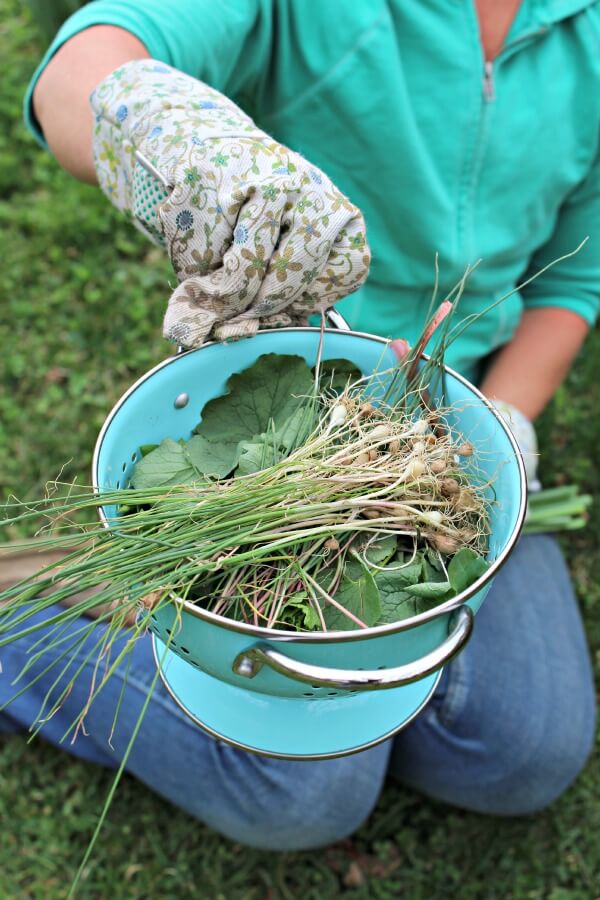
Once I see the first signs of spring I get so excited! Want to know why? Because I know that I don’t have to purchase any more greens at the store. I can find them for free, growing in the wild, right in my backyard!
If you thought you had to wander and hike through miles of fields and woods to forage edible wild food, guess again! The truth is that you can do it right in your very own yard.
Even if you have just a tiny strip of grass as your front lawn, I bet you can even find at least 2 out of the 5 plants down below. Other places to look for these common spring wild edibles are parks, fields, and woods. If it’s not your property, it’s a good idea to ask permission before you go pick. I’ve found that generally people don’t mind at all because most people consider these pesky, nuisance weeds and are happy to have them gone.
Why should you look for wild edible plants?
Because it’s fun! And because it tastes good! Because it’s more nutritious than what you get at the store! Because you’re outside experiencing the wonders of nature! I could go on and on. But there’s something so satisfying and thrilling about the discovery of finding edible wild plants. I bet you’ll find that it’s way more fun eating greens picked from your backyard than greens that you got at the store, too 🙂
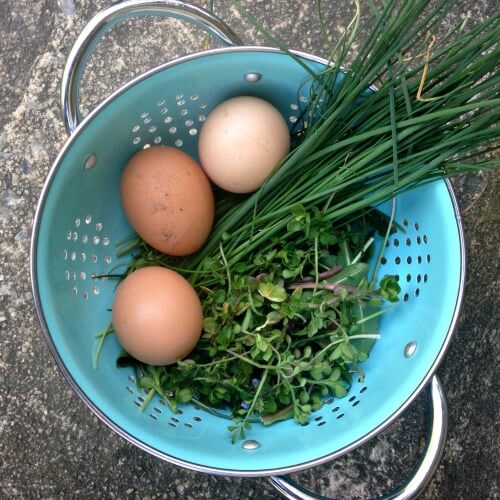
Just a few words about foraging safety
I couldn’t say this better myself so I’m going to quote Dr. John Kallas, who wrote one of my favorite foraging books, Edible Wild Plants. It’s exactly how I feel, not only about the safety of wild plants, but about life in general.
“Look, you can either curl up under your bed covers and live a safe, dull, insulated life reading about other people doing things you wish you were doing. Or you can join the real world. If you venture into the real world, you risk living your life to its fullest. You risk the rush of climbing that mountain, of dancing all night, of scuba diving in reefs of mind-blowing color, of standing in the rain on an ocean viewpoint…… you risk getting exercise and breathing fresh air. You risk making life worth living. So if you decide to venture into the world of wild foods, you’d bettered prepare yourself for some fun, adventure, and risk. Yes, there are risks to eating new foods that you’ve never tried before. You might make some mistakes or have allergies to foods that you haven’t been exposed to yet. But if you are a reasonable student, if you don’t just jump haphazardly into eating everything in sight, and if you pay attention to what your body is telling you, your chances of any real danger are slim.” – Dr. John Kallas, author of Edible Wild Plants
Amen, Dr. Kallas, Amen!
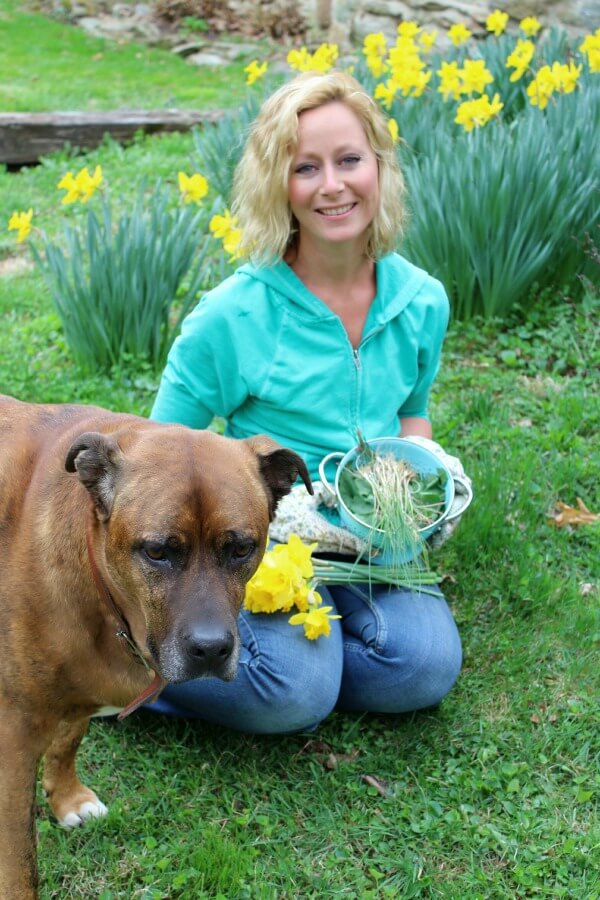
So let’s have some fun and take a walk in my backyard. My photo bombing dog, Bently and I will show you what edible wild plants to look for 🙂
Chickweed
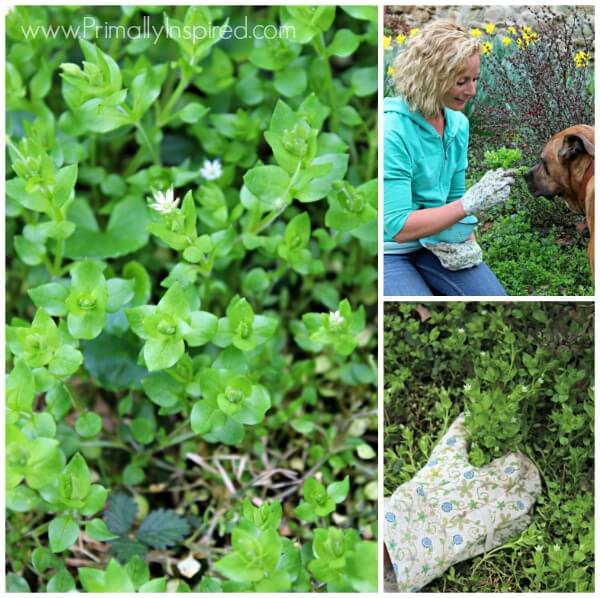
Chickweed is one of my favorite wild edible greens. It has a mild, delicate, pleasant taste and texture. It’s so pleasant tasting that I think it’s best eaten raw, even though you can most definitely sauté or cook it, too. I love eating chickweed in a salad. It’s a nutritional powerhouse and extremely high in iron and zinc, higher than any of the domesticated greens.
Chickweed starts to sprout up at the first signs of spring so look out for it – it’s so common and can be found all over! Chickweed has 4 edible parts – the leafy stem tips, the leaves, buds and flowers. Chickweed flowers are very tiny and white. You’ll want to cut only the first 2 inches of the tips – those are the most tender.
Garlic Mustard
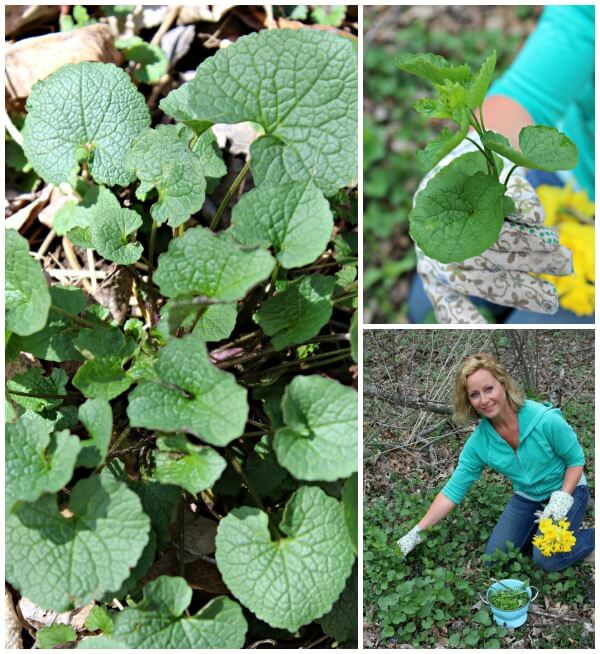
Garlic Mustard is a very invasive plant. You can find it everywhere! I happen to love the taste of garlic mustard because it has a wonderful garlic flavor. If you are a garlic lover, I think you’ll especially enjoy this wild green. Plus, it’s insanely nutritious, too! In fact, it’s one of the most nutritious leafy greens ever analyzed! It’s higher in fiber, beta-carotene, Vitamins C and E, and zinc than either spinach or kale!
There are many stages of garlic mustard, but it’s best eaten during the spring, when the leaves are tender and young. If you harvest it after spring, it’s much too bitter to eat. Most people love to make pesto out of garlic mustard. Just add olive oil, a squeeze of lemon, salt, pepper and a nut of choice and you’ve got a killer tasting pesto! I especially love using garlic mustard in egg dishes like a frittata or omelettes. Lately, I’ve been sautéing garlic mustard for a few minutes and then cracking a few eggs in the skillet for a fabulous breakfast hash.
Wintercress
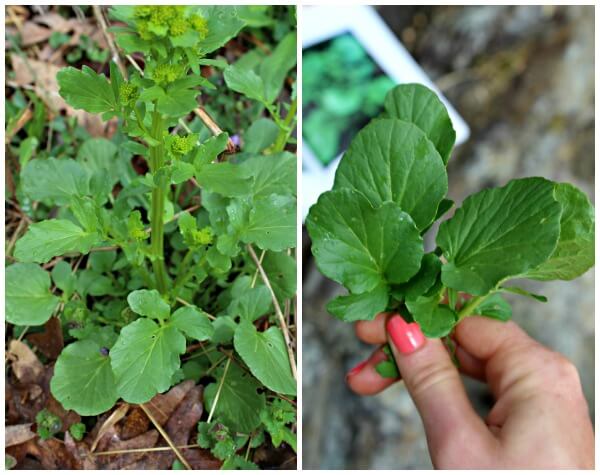
The leaves of wintercress can harvested all throughout the year, but it thrives wonderfully in the spring, when the weather is a bit cooler. Wintercress is abundant in Vitamin C and is a wonderful bitter green to aid in digestive benefits. In the early spring, wintercress looks much like the picture above.
But once the temperature warms up (usually around April or May), a quickly growing flowering stem emerges and produces a cluster of yellow flowers like this:
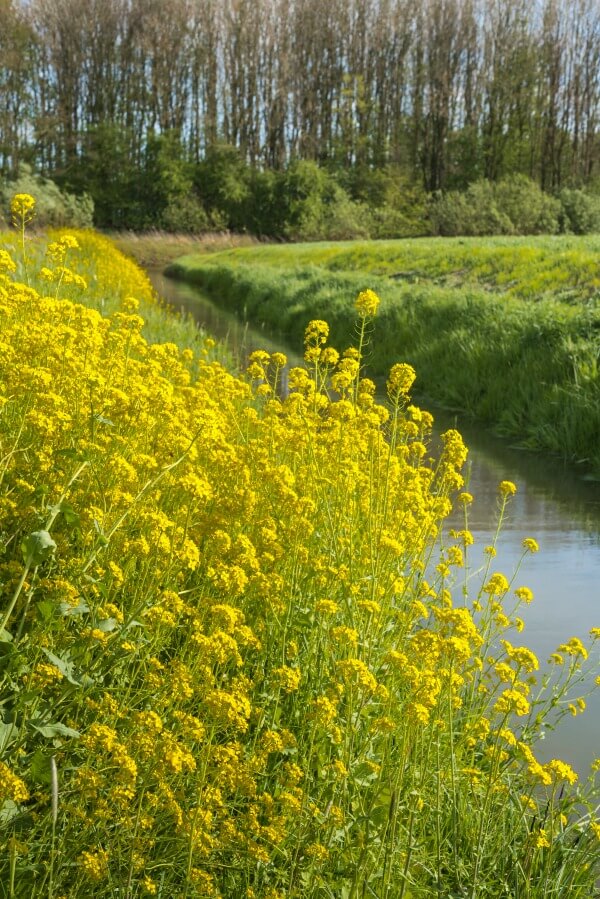
The leaves, buds clusters that look like mini broccoli heads, flowers, seeds and pods are all edible. Wintercress is bitter in raw form, so most people like to boil it to remove some of the bitterness. I think it’s best eaten not by itself, but mixed with other greens. The yellow flowers make a beautiful, edible and tasty garnish to food.
Field Garlic
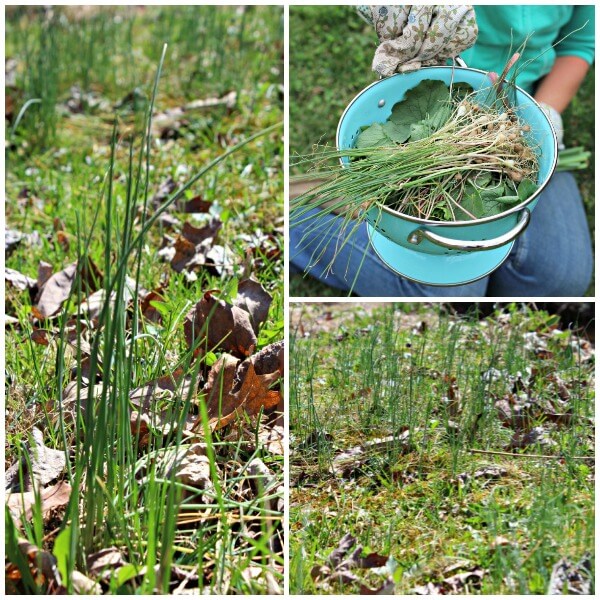
Field Garlic is one of my favorite wild edibles! I love garlic and field garlic is no exception. Although it looks and tastes like a cross between a garlic and an onion, it’s considered to be field garlic.
Field garlic loves to grow in yard lawns, fields and along roadsides. You’ll know you got the right plant if you smell an intense garlic and onion smell. You can harvest both the underground bulb and the green leaves.
Use the bulb just like you would garlic. Or you can snip the leaves and use it them as you would chives. I do both and don’t have to buy garlic or chives at the supermarket because I have an abundance of field garlic growing right in my backyard! I bet you do, too!
Dandelion
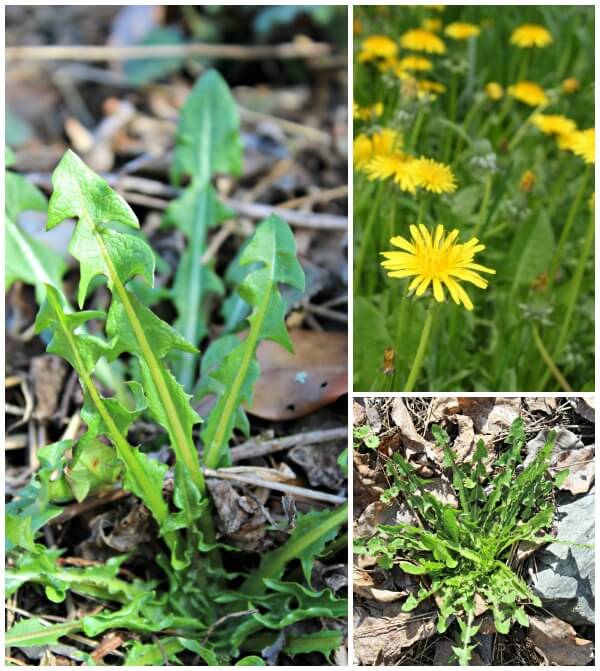
This is one edible plant that I’m sure your already familiar with. A dandelion is considered one of the most common weeds and you can find them all over – in gardens, your lawn, fields and parks. You can eat the leaves, flower buds, flower petals and roots. Dandelion greens are exceptionally nutritious and contain high levels of minerals, Vitamin A, calcium and potassium.
The spring is the best time to eat the leaves since they are much more mild tasting. Older leaves become bitter. I love eating the young spring leaves both raw and cooked. In the summer months, you’ll want to cook your dandelion leaves to get rid of some of the bitterness. I use spring dandelion greens any way that I would use any other store bought green.
You can also eat the dandelion flower petals! Make sure to separate the petals from the green base. That base is very bitter. Some people like to make a dandelion wine out of the petals and I’m going to try that this year 🙂 You can eat the dandelion root, too! Some people make a coffee tasting type beverage out of the root by roasting the root. You can learn how to do make a roasted dandelion root tea that tastes like coffee HERE.
Bently’s over it, so I guess that means we’re done foraging for today 🙂
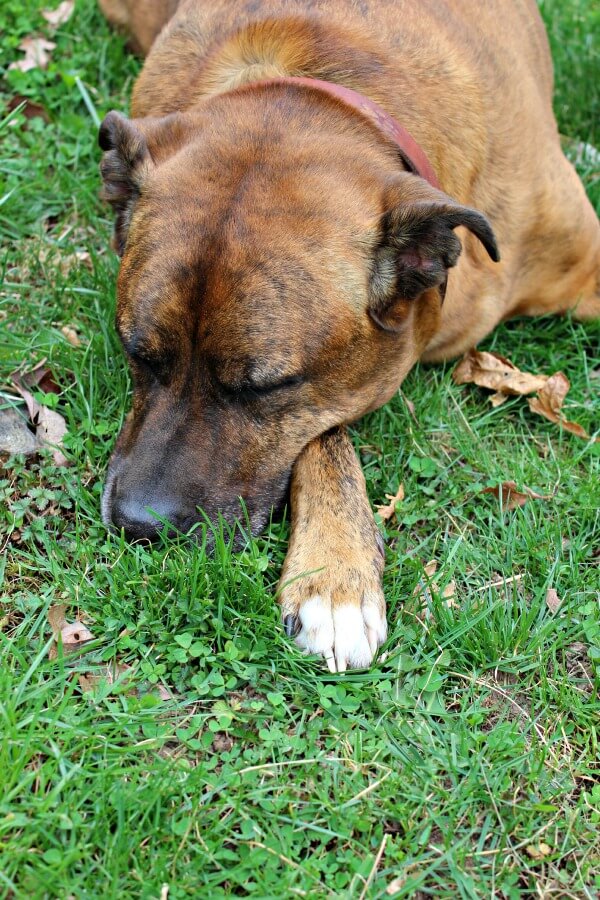
But wasn’t that fun?! And look at all my goodies! I can’t wait to make a big balsamic veggie pizza and chop up all those greens to use as a topping. I also really enjoy sautéing the wild greens to use in an egg breakfast hash. I’m not going to eat the daffodils – I just picked them to put some outdoor beauty and color on my kitchen table! 🙂
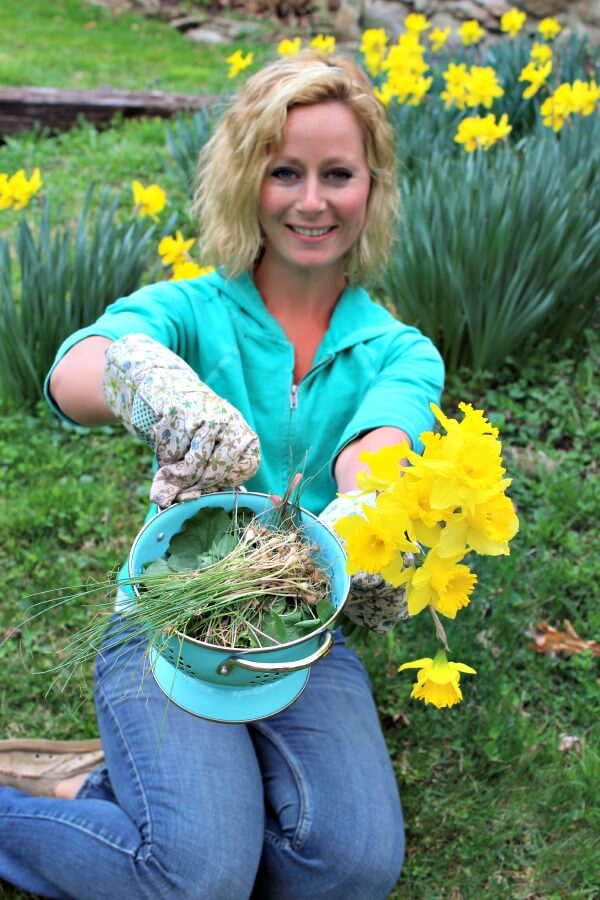
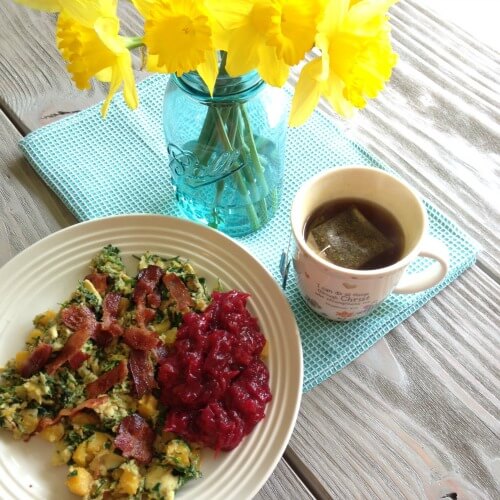
There are numerous other wild edibles that you can find all during the spring, but I chose to highlight the most common ones that are generally found in abundance right under your feet all over North America and Europe.
Want to learn more about foraging?
If you are interested in learning more about foraging and what plants you can eat, I have a few very well read foraging books that I would love to recommend to you. These particular books have greatly helped me in my search for edible wild plants:
Edible Wild Plants: Wild Foods from Dirt to Plate (Find HERE)
Nature’s Garden: A Guide to Identifying, Harvesting, and Preparing Edible Wild Plants (Find HERE)
Backyard Foraging (Find HERE)
Try it yourself and let’s talk!
I hope this post inspires you and helps open you up to the wonderful world of foraging. It’s so fun and a highly nutritious and inexpensive (free!!!) way to eat organic greens!
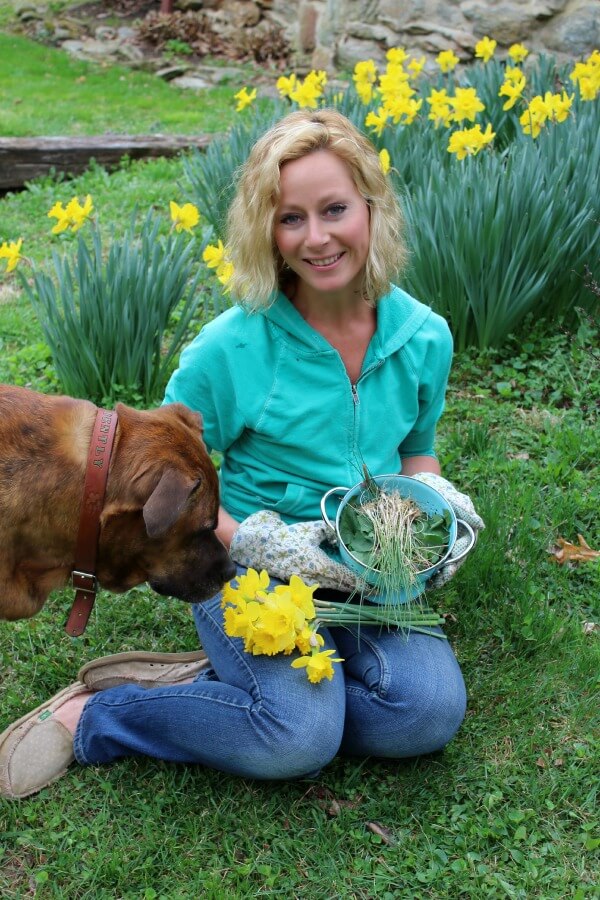
So now let’s talk – I love hearing your stories! Let me know if you’ve ever tried foraging. Did you know you could find all this free food in your backyard? Are you going to try it? Leave me a comment and let me know 🙂

Pin this Spring foraging post HERE:
 Primally Inspired Real food, Natural Remedies, Holistic Living
Primally Inspired Real food, Natural Remedies, Holistic Living






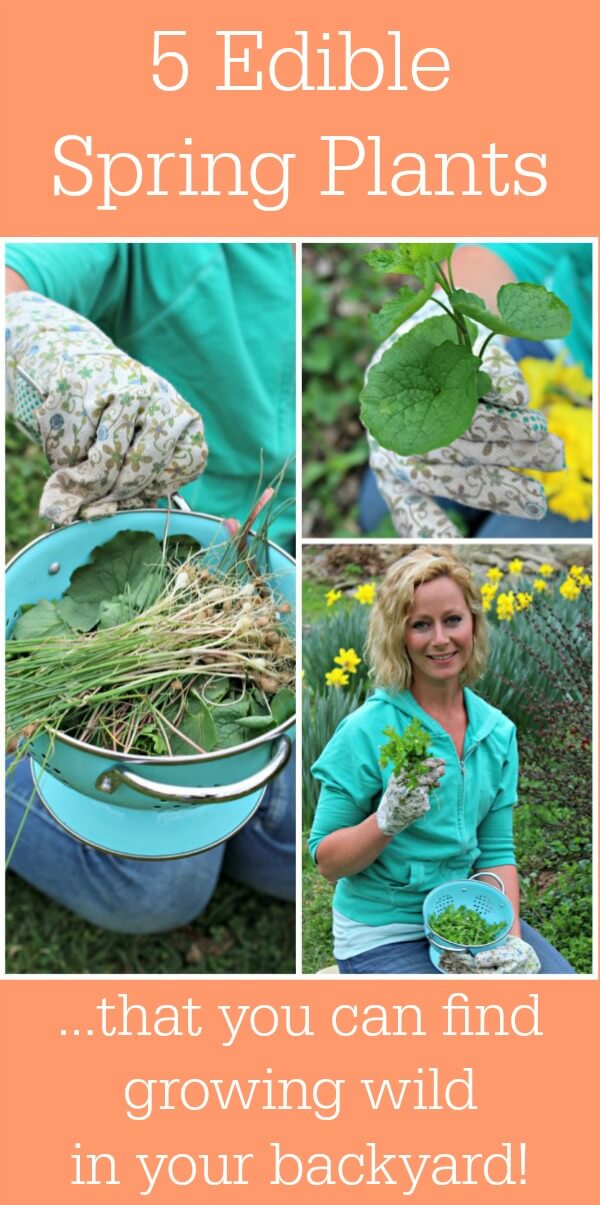
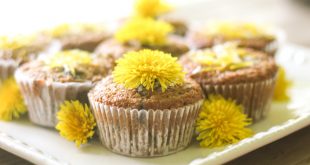
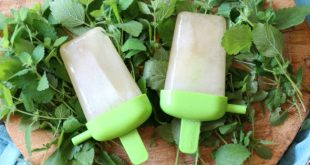
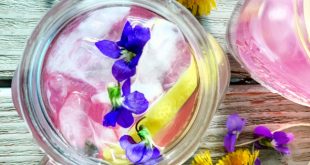
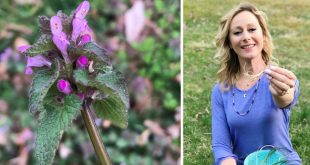
Great post as always! I didn’t know about the two mustard plants and am anxious to try them. Another good one is purslane. I usually see it later in the summer. The leaves are almost like a succulent, and it has a tart, lemony taste. It is very high in omega 3. In Europe it is cultivated and sold like other greens. Amazing what we have right in our own backyards!
Nice!! I will look for it this summer!
I was introduced to foraging by my father when I was young. This week I found some wild asparagus and made a quiche. Soon it will be time to hunt morels. If I’m lucky I will find some greens from your list as well.
I am so jealous, Bonnie! I went hiking for wild asparagus, but couldn’t find any – I will keep trying 🙂 Can’t wait until I can find some morels – love them!
lambs quarters are my favorite…
Love them, too Carol!
Hi Kelly,
What a great web site. Thanks you for bringing attention to my “Disclaimer” (Foraging Safety above). Often when people buy non-fiction books, they skip past all the chapters that cover concepts and head right for the plants. You apparently read the whole book and benefitted from it. My heart and soul went into volume 1 of my book series and I think that is apparent in my disclaimer.
Good luck to you and happy foraging. Spring is almost upon us.
John Kallas
Wild Food Adventures
Portland Oregon
I am so excited to get a comment from you, John! Your passion, enthusiasm and personality shines through in your writing. They say the best teachers are the ones who inspire others and whenever I read your work, I get so inspired.
I still have a lot to learn with foraging, but am getting better and better each season. I enjoy it so much! Your comment here made my day – thank you for taking the time to reach out and help me out!
Enjoy your spring season!
Warmly,
Kelly Winters
Last week I went out into the woods and collected a bag full of wild leeks (also called ramps). Both the leaves and bulb are edible—and delicious. It looks very similar to lily-of-the-valley, so be careful. The leek bulb has a noticeable garlic smell, which distinguishes it from the lily-of-the-valley.
So cool, Mary! Thank you for sharing. I will look for them – I love, love, love leeks!
I have eaten dandelion leaves since I was a kid .wilted . Use a wilted. Lettuce recipe and young dandelion in the spring. I could never get enough!!
Awesome!!